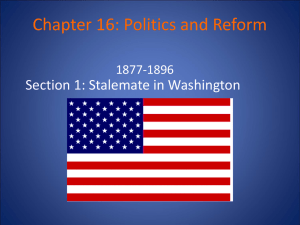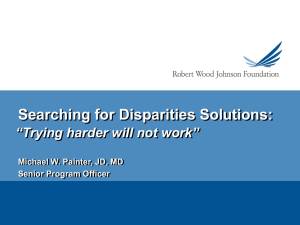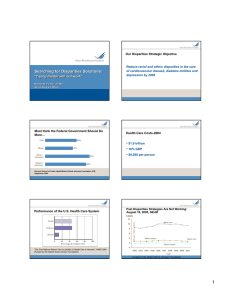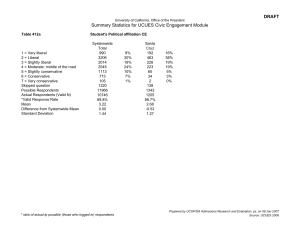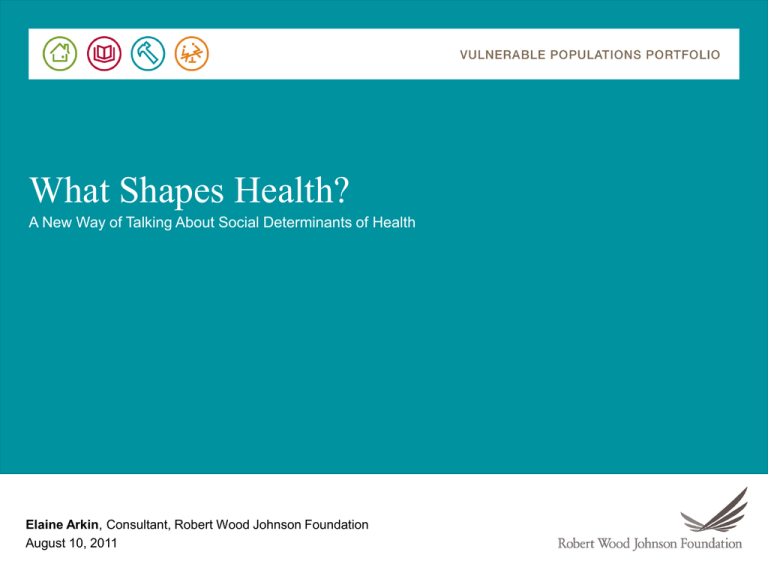
What Shapes Health?
A New Way of Talking About Social Determinants of Health
Elaine Arkin, Consultant, Robert Wood Johnson Foundation
August 10, 2011
The mission of the Robert Wood Johnson
Foundation is to improve the health and
health care of all Americans.
There’s More to Health than Health Care
3
© 2008 Robert Wood Johnson Foundation. All rights reserved.
Area-based measures of poverty and deprivation have been found to
be associated with health outcomes after adjustment for individuallevel factors. Additional studies have suggested that neighborhoodlevel variables may also shape the distribution of health-related
behaviors, although other studies have found little evidence of area
effects.
(Diez-Roux AV. ―Bringing Context Back into Epidemiology: Variables and
Fallacies in Multilevel Analysis.‖ American Journal of Public Health,
88(2):216-22, 1998
4
5
Where we live, learn, work and play can
have a greater impact on how long and
well we live than medical care.
6
7
7
8
The Commission’s Recommendations
9
1
Ensure that all children have high-quality early
developmental support.
2
Fund and design WIC and SNAP (Food Stamps)
programs to meet the needs of hungry families with
nutritious food.
3
Create public-private partnerships to open and sustain
full-service grocery stores in communities without
access to healthful foods.
4
Feed children only healthy foods in schools.
The Commission’s Recommendations
5
10
Require all schools (K-12) to include time for all children
to be physically active every day.
6
Become a smoke-free nation. Eliminating smoking
remains one of the most important contributions to
longer, healthier lives.
7
Create “healthy community” demonstrations to evaluate
the effects of a full complement of health-promoting
policies and programs.
The Commission’s Recommendations
8
Develop a “health impact” rating for housing and
infrastructure projects that reflects the projected
effects on community health and provides incentives
for projects that earn the rating.
9
Integrate safety and wellness into every aspect of
community life.
10 Ensure that decision-makers in all sectors have the
evidence they need to build health into public and
private policies and practices.
11
Message Development Approach
• Qualitative Audience Research
– 6 focus groups with “swing voters” and opinion elites
• Quantitative Audience Research
– National voter poll on messages derived from focus
groups
– Two rounds of message-effectiveness testing using
online surveys
• Interactive Messaging Workshop
• Story Development
12
Democrats
Democrats
Imbalance in levels of health is unjust.
Imbalance in levels of health is
natural.
Equality should be our goal.
- Equal distribution of resources
- Equal treatment for all
- Equal outcomes
Equality is unrealistic and unfair.
- Tailor the distribution of [limited] resources to
particular needs, not the same for all
- Individuals will never have equal outcomes.
We need to “level the playing field”
We need to raise the bottom.
Society bears primary responsibility for
inequality, thus to fix it requires more
change in society than in the individual.
Both society and individual choices create
disparities, thus social aid must be
balanced against individual responsibility.
Olsen Zaltman Associates, 2007
13
Republicans
Republicans
Democrats
Poverty
Poor Nutrition
Lack of insurance
Racial discrimination
Can’t Exercise
14
Access to Health
Care System
Can’t afford some
treatments
Discrimination
within Health
Care System
GOOD
Initial Health
Status
Cultural hesitancy
to see a doctor
Language barriers
prevent same level
of care
HEALTH
Less Parental
Supervision
Inadequate
Stress Transportation
Not enough easily
accessible facilities
Discrimination
based on sexual
orientation
BARRIER
Racism
Difficult to maneuver
through health care
system
BARRIER
Poor Education
BARRIER
Environmental
Hazards
Violence
Gender discrimination
Republicans
Bad choices
Initial Health
Status
15
Access to Health
Care System
Discrimination
within Health Care
System
GOOD
Cultural hesitancy
to see a doctor
HEALTH
- Poor public
education
about options
Difficult to maneuver
through health care
system
BARRIER
- Parents less
involved
Challenges
Lack of knowledge
CHALLENGES
Lack of
insurance
Lack of
money
Follow-up: 2011: National Voter Survey
%
Favorable
35
58
Message
There are often obstacles or barriers that make it harder for
some people to stay healthy than others. Providing people
resources and information on diet and exercise and creating
healthy policies can help people make healthy choices.
Staying healthy is a personal choice and is determined by
individual behaviors such as diet, exercise, not smoking, and
getting regular doctor checkups. Anyone can make the right
choices to stay healthy if they want to.
From National voter survey, 2011
16
Implication for messages
Republicans had negative reactions to the
idea of creating equal levels of health:
• Any variation of equal, equality,
or equalizing
• Leveling the playing field
• Bringing everyone to the same
point or the same health
outcomes
17
Instead, the following terms may resonate
more with Republicans and would not
alienate the Democrats:
• Raising the bar for everyone
-
Setting a fair and adequate
baseline of care for all
Lifting everyone up
• Giving everyone a chance to
live a healthy life
• Letting no person fall through
the cracks/ below a decent
level of health
What We Learned:
Using common vernacular that speaks to core values
resonated better than academic language
Respondents preferred messages that included action
items or examples of ways to get to a solution
18
What We Learned:
Messages that referred to disparities based on race or
ethnicity fared poorly with all but Black respondents
Respondents related to messages based on America’s
core values
19
What We Learned:
Respondents related to metaphors/concepts that are
ubiquitous—
– Journey
– Connections
– Limited Resources
20
Journey
21
Connections
Storytelling helps make the connections
22
Limited
Resources
23
Pair personal responsibility with social responsibility:
Good health requires individuals to make
responsible personal choices and requires a societal
commitment to remove the obstacles preventing too
many Americans from making healthy choices, even
when their motivation is great.
24
Start with something most Americans already believe:
The United States is one of the wealthiest
nations in the world. We should be one of the
healthiest, but we are not.
25
Considerations for Message Framing:
Make the information clear and
compelling without
oversimplifying:
Headline what’s most important.
Break through to gain attention:
Challenge conventional wisdom
with unexpected facts.
Make theories tangible:
Use real stories, analogies and
everyday language.
Connect with a target audience:
Stories about “people like me”
make the connection.
Make it timely and relevant:
Provide a call to action.
26
Unexpected Facts:
Our zip code may be more important to our
health than our genetic code.
For the first time, we are raising a generation of
children who may live sicker and shorter lives
than their parents.
27
Health Disparities:
The health of America depends on the health of
all Americans. Despite enormous investment,
America is not achieving its full health potential.
28
Health Beyond Health Care:
Health care reform is essential, but improving
the health of all Americans requires broadening
our view beyond medical care. We must find
ways to enable more people to lead healthy lives
and avoid getting sick in the first place.
29
Social Determinants:
Where we live, learn, work and play can have a
greater impact on how long and well we live than
medical care.
30
Robert Wood Johnson Foundation:
How We Talk About Health
Health starts in our families and it’s nurtured in our schools
and workplaces, on our playgrounds and in our
neighborhoods. How healthy we are and how long we live
depends on many factors, including education, income, our
local communities, whether we smoke, how active we are
and what and how much we eat.
32
To improve America’s health, we need solutions that look at
where people live, learn, work and play to get at the factors
that shape health even more profoundly than health care.
33
Working together, we can meet this challenge. We can
build a healthier America. Improving America’s health
requires leadership and action from every sector, including
people who work in public health and health care,
education, transportation, community planning,
corrections, private business and other areas. It is time for
everyone to work together and build on what we already
know is working.
34
Resources Available:
35
Message Guides:
36
37
38
Connect with Us:
What Shapes Health Home:
http://rwjf.ws/j9vmjn
Follow us on Twitter:
@RWJF
@RWJF_PubHealth
www.commissiononhealth.org
www.rwjf.org
www.newpublichealth.org
39


